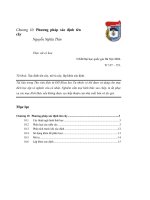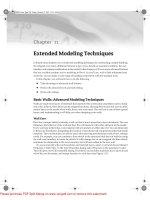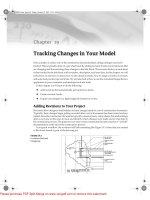Tài liệu Online Radio & Electronics Course - 38 - Transmission_Lines docx
Bạn đang xem bản rút gọn của tài liệu. Xem và tải ngay bản đầy đủ của tài liệu tại đây (273.91 KB, 14 trang )
Page 1
Reading 38
Ron Bertrand VK2DQ
TRANSMISSION LINES
A transmission line connects between a transmitter and an antenna and its purpose is to
deliver all the signal power to the antenna. A perfect transmission line does not radiate any
energy and does not have any losses.
Figure 1
Figure 1 transmission line examples:
(a) Parallel line - open wire - air dielectric.
(b) Parallel line - solid dielectric - typically 300 Ohms.
(c)(d) Parallel line - solid dielectric – round.
(e) Parallel line - solid dielectric - with shield.
(f) Coaxial line - spiral polythene dielectric ( low loss) - typically 50 Ohms.
(g) Parallel line - typical plastic dielectric - twisted pair - telephone line - typically
600 Ohms.
WHAT IS MEANT BY “CHARACTERISTIC IMPEDANCE” OF A TRANSMISSION LINE?
When an electromagnetic wave travels through free space, the current and voltage
distribution of the wave settles into a particular ratio. For free space, the current and
Page 2
voltage distribution of an electromagnetic wave settles into the ratio E/I equal to 120
Π
or
377
Ω
. So we say the characteristic impedance (Zo) of free space is 377
Ω
.
Similarly, when a wave travels along an antenna or in a
transmission line of infinite length,
the current and voltage distribution of the wave will settle to a particular ratio of E/I and this
is called the characteristic impedance (Zo) of that line. Now the reason why I said a line of
infinite length is to eliminate what is connected to the end of the line, that is, the load. We
will come back to this later and connect a load.
So for a particular transmission line of infinite length (and no losses by the way), we could
transmit a wave into it and literally measure the voltage across the line at any point, and
the current through the line at that point, and the ratio of E/I would give us the
characteristic impedance of the line in ohms.
WHAT IS A TRANSMITTER’S LOAD?
When you connect an antenna directly to a transmitter, the load for the transmitter is the
antenna. When we use a transmission line to connect a transmitter to an antenna located
elsewhere, the load for the transmitter is no longer the antenna. It is the transmission lines
input impedance which, under most circumstances, will be the same as the characteristic
impedance (Zo).
We have discussed before the importance of matching a source (transmitter) impedance
to a load (transmission line) impedance. Do you recall when we did the exercise on
connecting different resistors to a 6 volt lantern battery? Only when the resistance
connected to the lantern battery was equal to the internal resistance of the battery did we
get maximum power dissipated in the load resistor. Likewise for maximum power to be
transferred from the transmitter to the transmission line, the output impedance of the
transmitter must match the input impedance of the transmission line. Keep in mind again
that although we are talking about transmitters, the same applies to the reception of radio
waves.
WHEN IS A 50 OHM TRANSMISSION LINE ACTUALLY 50 OHM?
At first this may seem like a very silly question. After all, if you purchase 50
Ω
transmission
line you expect it to act like 50
Ω
line. Unfortunately, whether a 50
Ω
transmission line
behaves like 50
Ω
transmission line
depends on how we use it. Just because it has 50
Ω
written on its side is no guarantee that it will behave as 50
Ω
. That's up to us to ensure!
A
transmission line will only exhibit its characteristic impedance when it is terminated in its
characteristic impedance
. A 50
Ω
cable is 50
Ω
when it is connected to a load consisting of
50
Ω
of pure resistance
. If a transmission line is terminated in a load not equal to its
characteristic impedance, then the impedance on that line will vary from one point to the
next along its length due to the presence of
reflected waves.
FACTORS THAT DETERMINE CHARACTERISTIC IMPEDANCE
The characteristic impedance of any transmission line is a function of the size and spacing
of the conductors and the type of insulating material (dielectric) between them (refer to
figure 2).
Page 3
If the distributed inductance and capacitance per unit length of a line
is known, then the characteristic impedance can be found from:
For distributed inductance and capacitance per unit length you can actually measure, or
look up from cable data, what the L and C of a cable is for say a one metre length. Using
this L and C you can calculate the Zo.
Figure 2.
RANGES OF Zo
In the design of transmission lines there are certain constraints which restrict the range of
practical impedances that can be achieved. For two wire parallel lines the Zo is usually
restricted to a range of 100 to 600 ohms, while for coaxial lines the practical range of
characteristic impedance is typically 30 to 100 ohms.
Interestingly, though I don’t have the space to fully explain why, it is no accident that in
radiocommunications a Zo of 50 ohms is most common for transmission. However, for
receive-only systems 75 ohm cable is the most common. The reason? It can be proven
that 50 ohms is the best compromise between power handling ability and losses, whereas
75 ohm cable is optimised for having low losses with no regard to the power handling
ability.
BALANCED AND UNBALANCED LINE
On a balanced line, such as a parallel wire line, the impedance between each leg of the
line above the earth is the same. This line is said to be "balanced". On the other hand, a
coaxial line has a larger outer concentric conductor with a smaller diameter solid conductor
through the centre. Because of this construction, it is impossible for each leg of the line to
have the same impedance above earth. A coaxial line is said to be "unbalanced".
If you find this concept hard to understand, imagine placing an ohmmeter between each
side of a parallel line and ground (as in dirt, earth). You will measure a very high
Page 4
resistance (impedance) in the megohm range. However you will measure the same value
between each leg and ground. This line is balanced. This is why we have twisted pair
cable, and why 300 ohm ribbon is often twisted - in order to maintain the balance. A
coaxial line on the other hand has its centre conductor at megohms above ground while
the sheath (outer conductor) is at ground - definitely an unbalanced line.
A two wire parallel line such as 300 ohm TV ribbon will “behave” as balanced line only if it
is installed correctly. In a TV installation, this line must be held away from metal structures
such as the antenna mast, by using stand-offs. If this were not done, the metal structure
would unbalance the line and alter the characteristic impedance. A correctly installed 300
ohm TV feeder is twisted at least once every 150 mm. The purpose of this is ensure that
each side of the line is "influenced" to the same degree by nearby objects such as metal
storm water down pipes. Attaching 300 ohm ribbon to a wall using thumb tacks driven into
the centre of the dielectric is absolutely out for the same reasons (don't laugh, I have seen
it done often). The latter practice is commonly found in domestic TV installations and
frequently leads to poor reception and interference. Balanced line is difficult to install in
order to maintain the balance between each leg. Having said that, parallel balanced lines
have much lower losses than coaxial lines.
WHY BE CONCERNED?
If a balanced line is installed correctly, then induced currents from your amateur
transmissions will flow in opposite directions on each leg of the TV line and be equal in
amplitude, thus completely cancelling out and greatly reducing the possibility of
interference (for the same reason, a parallel line does not radiate when used on a
transmitter). If however the line is unbalanced, it will function more like a long wire
antenna and funnel your amateur signal into the TV set, greatly increasing the chances of
interference.
A coaxial line is unbalanced by virtue of its non-symmetrical construction. At the
transmitter it is usual practice to connect the outer conductor to ground. The cable can be
run anyway you like, and can even be buried in the ground (preferably in conduit). The
induced voltages in the shield are conducted to earth and do not affect the shielded inner-
conductor circuit.
VELOCITY OF PROPAGATION
The velocity of propagation is the speed with which an electromagnetic wave travels
through a transmission line. The velocity of propagation within a line depends on the
construction of the line. In particular, the dielectric used can significantly alter the velocity
of propagation. Manufacturers of transmission line describe the velocity of propagation by
stating the velocity relative to the velocity of light (or any other electromagnetic wave) in
free space, commonly referred to as the velocity factor. The velocity factor can range from
0.56 to 0.95 depending on the type of cable. A line with a velocity factor of 0.66 means
that the wave can travel along this line at 66% of light velocity (light velocity = 300,000 km
per second).
Some typical velocity factors are:
1. Parallel line, air dielectric, 0.95 - 0.975
2. Parallel line, plastic dielectric, 0.80 - 0.95
3. Coaxial, air dielectric, 0.85
4. Coaxial line, polythene dielectric, 0.66
Page 5
The most important ones to remember for everyday use (and for the exam) are
0.66 for
coax and 0.80 for 300 ohm parallel line. If you use something else look up the velocity of
propagation on the manufacturers data sheet.
There is an interesting approximation for determining the velocity factor of coaxial lines.
The reciprocal of the square root of the dielectric constant is a close approximation to the
velocity factor. Polythene has a dielectric constant of 2.3. So a coaxial line with a
polythene dielectric has a velocity factor of: 1/(square root 2.3) = 0.659 or 0.66 rounded.
A LINE TERMINATED IN ITS Zo
An electromagnetic wave is travelling down a transmission line but has not yet reached the
load. Remember, a wave travels at a finite velocity, a fraction of the speed of light. As it
travels its current and voltage distribution, or ratio E/I, will be equal to the Zo of the line.
The wave has not reached the load – it is on its way down the line. The current and
voltage of the wave must obey Ohm’s law. When the wave reaches the load, which is
equal in impedance to the Zo, it will be totally dissipated in the load or radiated if the load
is an antenna. Such a line is called a flat line as it has no standing waves.
REFLECTED WAVES
An electromagnetic wave upon reaching a mismatched termination, must conform to
Ohm’s law. You need to imagine a wave travelling in a transmission line of infinite length.
The voltage and current ratio (E/I) of the wave will be that of the characteristic impedance.
Now let’s do away with the infinite line and place a load at the end of the line. The wave
has not reached the end of the line yet, so its E/I distribution is still representing the
characteristic impedance (Zo). If the load is not equal to the Zo, the wave upon reaching
the load must go through a current and voltage redistribution so that E/I now represents
the load impedance. To do this, the wave goes through a sudden redistribution of the
energies contained in its magnetic and electric fields, so that the current and voltage
across the load represents the load impedance.
In going through a redistribution of current and voltage, an induced current and voltage
wave is created (Faraday's law of induction), and this new wave opposes the wave that
created it (Lenz’s law).
The induced wave will now begin to propagate through the line
back towards the generator or transmitter. This is called a reflected wave. How much of
the incident wave is reflected and how much is dissipated (or radiated) in the load is
determined by the amount of mismatch between Zo and the load impedance (Z
L
).
Again - a wave, before reaching the termination (load), has no knowledge of the
termination conditions. The waves current and voltage distribution will be representative of
the characteristic impedance of the line. As close as one micron (a millionth of a metre)
away from a load, the wave is still unaware of the conditions at the load. Suddenly, upon
reaching the load, an instantaneous change in impedance occurs. The voltage and current
must now redistribute themselves to conform with the Ohm’s law value established by the
load. This rapid redistribution causes an induced reflected wave which travels back down
the line from the load.
A line
not
terminated in its Zo will have an incident or forward wave and a reflected wave
travelling in the opposite directions.









